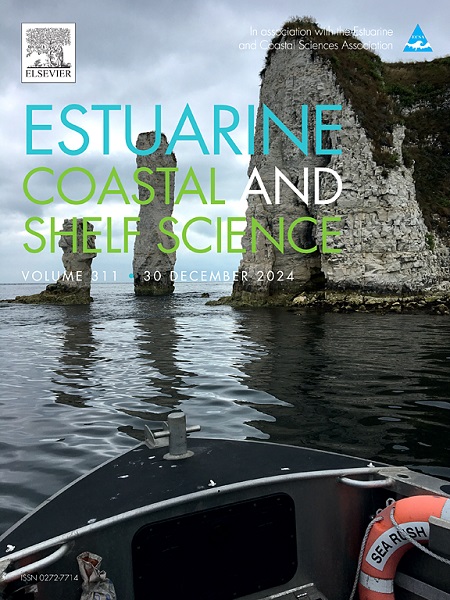沙滩轮廓形状分类的定量方法
IF 2.6
3区 地球科学
Q1 MARINE & FRESHWATER BIOLOGY
引用次数: 0
摘要
河口湾沙滩在全球范围内普遍存在,其存在依赖于区域和局部波浪、有限泥沙输入、潮汐动力学和人为干预等复杂的相互作用。BEB形态动力学的定义很差,只有少数研究试图定性地将不同的BEB剖面形状与相关的物理驱动因素联系起来。在这里,我们提出了一个新的剖面形态指数(Γ)来定量地将beb中海滩剖面的形状划分为不同的形态类型,以便客观地分析海滩形态动力学状态的变化。在这项研究中,在2016年至2023年期间,对Gamay-Botany湾(澳大利亚新南威尔士州)三个斜向和一个漂向的beb的海滩剖面进行了定期测量,总共进行了774次海滩剖面调查。基于此数据集,我们定义了计算轮廓形状的方程,将其分配给特定的形态类型。10种独特的形态类型形成了新的形态测量指数(Γ),在凹形(Γ =−1.000)和凸形(Γ = 1.000)剖面形状之间逐渐变化,分别表示更多的侵蚀和增生海滩状态。结果表明,离河口口最近的侵蚀带以凸型为主(Γ = 1.000),离河口口最远的侵蚀带以凹型为主(Γ =−0.570 ~−0.950)。形态测量指数还捕获了由于高能风暴波传播到河口而引起的剖面形状的变化。这种新的形态指数(Γ)提供了BEB剖面形状的客观分类,使我们能够更好地预测海滩状态对海岸过程和水动力变化的响应。本文章由计算机程序翻译,如有差异,请以英文原文为准。
A quantitative approach to classify the shape of beach profiles
Sandy beaches in estuaries and bays (BEBs) are common globally, and their existence relies on the complex interactions of regional and local waves, limited sediment input, tidal dynamics, and human interventions. BEB morphodynamics are poorly defined with only a few studies attempting to qualitatively relate different BEB profile shapes with relevant physical drivers. Here, we propose a novel Profile Morphotype Index (Γ) to quantitatively classify the shape of beach profiles in BEBs into distinct morphotypes to allow an objective analysis of changes in beach morphodynamic states. For this study, beach profiles in three swash-aligned and one drift-aligned BEBs in Gamay–Botany Bay (NSW, Australia) were measured periodically between 2016 and 2023, resulting in a total of 774 beach profile surveys. Based on this dataset, we defined equations that compute the profile shape assigning it to a specific morphotype. Ten unique morphotypes form the new morphometric index (Γ) varying gradually between Concave (Γ = −1.000) and Convex (Γ = 1.000) profile shapes, which indicate more erosive and accretive beach states, respectively. Our results show that those BEBs closest to the estuary entrance favoured the Convex (Γ = 1.000) morphotype, while BEBs farthest from the entrance and under erosive conditions were Mostly Concave (Γ = −0.570 to −0.950) morphotypes. The morphometric index also captured changes in profile shape due to high-energy storm waves propagating into the estuary. This new morphotype index (Γ) provides an objective classification of BEB profile shape allowing us to better predict beach state response to changes in coastal processes and hydrodynamics.
求助全文
通过发布文献求助,成功后即可免费获取论文全文。
去求助
来源期刊
CiteScore
5.60
自引率
7.10%
发文量
374
审稿时长
9 months
期刊介绍:
Estuarine, Coastal and Shelf Science is an international multidisciplinary journal devoted to the analysis of saline water phenomena ranging from the outer edge of the continental shelf to the upper limits of the tidal zone. The journal provides a unique forum, unifying the multidisciplinary approaches to the study of the oceanography of estuaries, coastal zones, and continental shelf seas. It features original research papers, review papers and short communications treating such disciplines as zoology, botany, geology, sedimentology, physical oceanography.

 求助内容:
求助内容: 应助结果提醒方式:
应助结果提醒方式:


